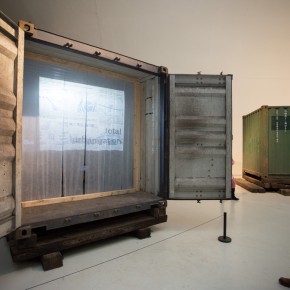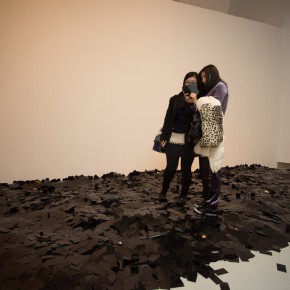
By Meng Yuan
The Second CAFAM Biennial which is entitled “The Invisible Hand: Curating as a Gesture” opened on February 28, 2014. At first glance, the entire exhibition seems to fully focus on “the invisible hand”, both curators and artists are paranoid trying to manipulate people. We see the creative idea from the unpleasant and funny discourse, while two hands seal our mouths, and allow people from different countries to imitate Chinese pronunciation; the hands plug our ears so that we can’t ignore the sound “This is not political propaganda”, when I am surprised by the loud voice of a senior woman, I see the irony in Tino Sehgal’s style; the hands control our hands and feet and ask us: “Are you ready to be a marionette?”“Have you learned?”, so that the posters and items used as safety publicity at the Department of Labor in Hongkong has a new meaning in the art exhibition. Although sealing our mouths, plugging our ears, controlling our hands and feet, “the invisible hand” fails to hold our thoughts, because thought is invisible, belongs to ourselves, and is a result that the objective's existence reflects in people’s consciousness and starts thinking about activities. However, does the “invisible hand” aim at highlighting the importance or creativity and power of the curator? I think the 2nd CAFAM Biennale discusses a more in-depth issue, I prefer to consider “the invisible hand” as an “institution”, and the exhibition is very clear that the contemporary art outside the institution searches for a suitable position for curating inside the institution, and a trial that art outside the institution shakes hands with the one inside the institution.
As teacher Yi Ying says, curating and contemporary art is not compatible in essence, one is inside the institution while another one is separated from the institution. Curating in the institution, curators mainly have contact with mature and successful contemporary art, or the institutionalized ones; but contemporary art is a group of marginalized people who do art creation in order to fight against the institution, and they are in pursuit of discord and unstable art effects. Then we can say that curating and contemporary art are fundamentally two contradictory individuals, so that it seems impossible to finish the task of curating a contemporary art exhibition in theory. While the deep meaning and task of the Biennale is to delete the irreconcilable between the curating and contemporary art. Thereby it shows the audience the collision and harmony between curating and contemporary art.
In short, “institution” means the rules and disciplines, while “anti institution” is to challenge and break the institution. Curating is a double-edged sword, for curators, it is a kind of institution that brings them endless convenience and order for the work from planning an exhibition to the presentation of it; for contemporary artists it is an institution that restricts freedom and boundless creativity. The meaning of constraint and the freedom is opposite, to help freedom find contemporary art its position in the constraint, it is in need of finding a middle ground between the freedom and constraint, which is a peace meeting, in order to make both sides shake hands in a friendly manner. Making the “invisible hand” which hinders the creation advance, let go of artwork and for the audience in order to release the thinking of the audience, the effect is that the six curators searching find the method through constant exploration and experiment through their unique ways. Whether it is Angela Jerardi’s Game Theory, or Hu Danjie’s The Code of The Golden Bough-Economics of Witchcraft, Soul, and Faces, whether it is Kit Hammonds’s No Puppet Is Dumber Than Its Puppeteer, or Ma Nan’s The Museum Cellar, whether it is Veronica Valentini’s On Ambiguity and Other Forms to Play With, or Xiaoyu Weng’s “Parliament of Things, or, Wandering in a Continuously Bewildering Wonder”, the six curators confirm the idea in the six sections of the exhibition.
The collision between curators and artists left traces in each section, the whole CAFAM Biennale is a chess game to play with the invisible hand. Xiaoyu Weng from California College of the Arts, San Francisco, USA, is undoubtedly a clever curator. She deliberately gives the section a long and strange name, in order that the audience can’t remember and understand the title when they see the show, so that her invisible hand as a curator influence the thinking of the audience to a minimum when they see it. Her exhibition aims at continuously bringing the audience a sense of curiosity and is confused, so that the audience stroll among her careful selection of works witha mixture of two senses.
Then how does curating live in harmony with contemporary art in her exhibition? Her secret is probably to overlap artwork and the creativity of curatorial practice. Alexndre Singh’s work with a laser horizontal and vertical measuring instrument and an extremely accurate number highlights the creativity of labor force working as rationally as machinery all the time. Dozens of carefully arranged and orchestrated photos and collages seems to tell a story to the audience. The narrative of such a story starts from Le Louvre Museum, like a shooting film, the artist appreciating works in the museum of the institution, then runs away from the institution and creates in the field, and finally the work is sold to the art market. Going in and out the institution is the real creating process of the artist, in the last picture, a few coins are on the unfolded hand, as if in the telling of the little market value of his contemporary art when it is accepted by the institution, but the real value is creation itself. Alexndre put the pictures on the wall to record and showcase his own creative process to the audience, in such a way, it also integrates curating and contemporary art.
Another one is the video work of Javier Tellez from Venezuela, as the video is screening, someone initially pulls out an elephant to the square, following that some people go forward to feel the elephant one after the other, which is a familiar fable that the blind men feel an elephant – to take a part for the whole. He said that because the exhibition was held in native China, so that he would like to take a story that was familiar with the local people as the background to express his art idea. Someone in the video says: “It feels like feeling a tire, the difference is that it has a temperature.” As the product of the industrial age tire so becomes cold, lifeless, is the symbol of commercial society; while the elephant is warm, life is a gift of nature. We may not distinguish scenery from the reality in real life, and even doubt everything, I have no idea whether I choose it according to my will, and also have no idea that to escape from the vortex of the reality.
I am also glad to exchange idea with Chinese artist Li Ran. Several slices of color glasses in different sizes are hung on the ceiling, which is like a three-dimensional work of Mondrian, and a sofa is placed in the roughly circular space enclosed by using glass boards, which makes me realize that the difference between the depth of thought may be the difference between the inside of the circle or the outside, between hanging a painting or not. When the work is finally finished, the artist sits on the sofa or roams around in this small space, sometimes he transcribes notes or takes picture or paints. Li Ran thinks Chinese contemporary art has faults, so there isn’t a clear diachronic relation, so that artists often create work but don’t know what they are doing, therefore, he wants to clear up the context of the historical text.
Harrell Fletcher from America, I am impressed by his boldness, when others are trying to get rid of the control of the institutional “invisible hand”, or urgently remove the relationship with the institution, he freely and cleverly uses the institution to reconstruct a museum to be the artwork of the exhibition. The reconstructed museum is named “American War”, which is built on the basis of the archives, information and photos in the Vietnam War Memorial Hall. When Harrell participated in anti war activity in Vietnam, he wanted to learn the view of the local people, but the Vietnamese always kept from talking about it, then he visited the memorial hall on the recommendation of the people. In addition to being shocked by it, Harrell thought about a way to share his feeling with his fellow countrymen, therefore, he took a lot of pictures of the war in the memorial hall with a handheld camera in the last few days before he left. So we see the memorial hall which was reconstructed when he arrived in China.
I write the article with the inspiration of Yi Ying, from the perspective of the relationship between curating and contemporary art, the “invisible hand” is extended from the gesture of curating to “institution”, starting from the section of Xiaoyu Weng’s “Parliament of Things”, to discuss the trial of several possibilities for contemporary art going into the curating institution.
(It was originally published in “New Youth Art Salon” Weixin platform)
Translated by Chen Peihua and edited by Sue, Photo by Hu Zhiheng/CAFA ART INFO.

















































